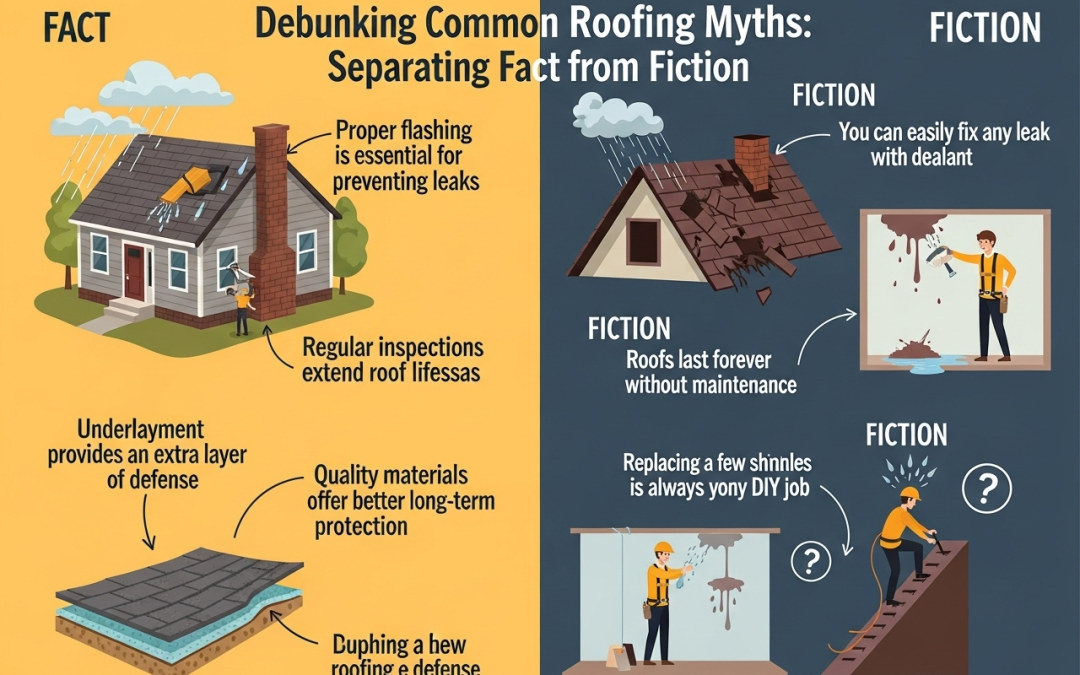Your roof plays a vital role in your home, yet the roofing industry is rife with misconceptions. Understanding the facts can help you avoid expensive errors and guarantee that your home is adequately safeguarded. This guide clarifies some of the most prevalent roofing myths.
Myth 1: “You can just put new shingles over the old ones.”
Reality: Although a “layover” or “re-roof” may appear to be a budget-friendly option, it is nearly always an unwise choice.
A fresh layer of shingles is placed over the existing roof decking. If there is any rot, mold, or damage to the underlying wood, it will remain undetected and unaddressed. Essentially, you are installing a new roof on a compromised foundation.
Shingles are quite heavy. The addition of a second layer imposes considerable, unnecessary strain on your home’s structure. This can also lead to the new shingles being installed unevenly, resulting in a wavy appearance for your roof. Furthermore, most shingle manufacturers will void their product warranty if the shingles are not applied to a clean, adequately prepared surface. Consequently, your new roof will not be protected if any issues arise.
The proper method is always to perform a complete tear-off, which enables a professional roofer to examine and repair the decking prior to the installation of a new, flawless roofing system.
Myth 2: “My roof warranty covers everything.”
Reality: This is a prevalent and hazardous assumption. Many homeowners conflate two distinct types of warranties.
Manufacturer’s Warranty (Product Warranty): This warranty, issued by the shingle manufacturer, addresses defects in the roofing materials themselves. For instance, if the shingles curl or prematurely lose their granules due to a manufacturing defect, this warranty may provide for a replacement. However, it does not cover problems arising from poor installation, storm damage, or inadequate maintenance.
Roofer’s Workmanship Warranty: This warranty, offered by your roofing contractor, pertains to the quality of the installation. If your roof experiences leaks due to incorrect installation of the flashing or improper nailing of the shingles, this warranty will offer you protection. A robust workmanship warranty indicates a trustworthy and confident contractor.
Always request a detailed explanation from your contractor regarding what each warranty encompasses.
Myth 3: “I can fix a small leak with caulk or tar.”
Reality: Although roofing cement and tar are readily available at any hardware store, they serve as temporary fixes rather than long-term solutions.
Applying a small amount of tar may temporarily halt the leak, but it does not address the root cause of the problem. The source of the leak could be due to a fractured shingle, deteriorated flashing, or a more significant issue that is not immediately visible. Additionally, the thick, black tar can hinder a professional’s ability to identify the true origin of the leak and can trap moisture beneath it, resulting in wood decay.
A qualified roofer possesses the expertise to trace the leak back to its source. They will either repair or replace the compromised materials, ensuring that the issue is permanently resolved rather than merely concealed.
Upon discovering a leak, regardless of its size, the most prudent course of action is to contact a professional for a thorough inspection and repair. The safety of your home is far more valuable than a quick, temporary solution.
Conclusion: Trust the Experts, Not the Myths
Your roof is a crucial aspect of your home that should not be left to chance or misinformation. The myths we have dispelled all share a common theme: they represent shortcuts that may result in more serious and costly issues in the future.
The secret to a durable and safe roof lies in a blend of high-quality materials, skilled craftsmanship, and a professional’s meticulous attention to detail. By collaborating with a reputable and seasoned roofer, you are not merely obtaining a repair or replacement; you are securing peace of mind.
Do not allow these prevalent myths to jeopardize your home. Should you have any inquiries regarding the condition of your roof or if you are worried about a possible problem, please consult a qualified roofing expert for trustworthy and dependable guidance.

